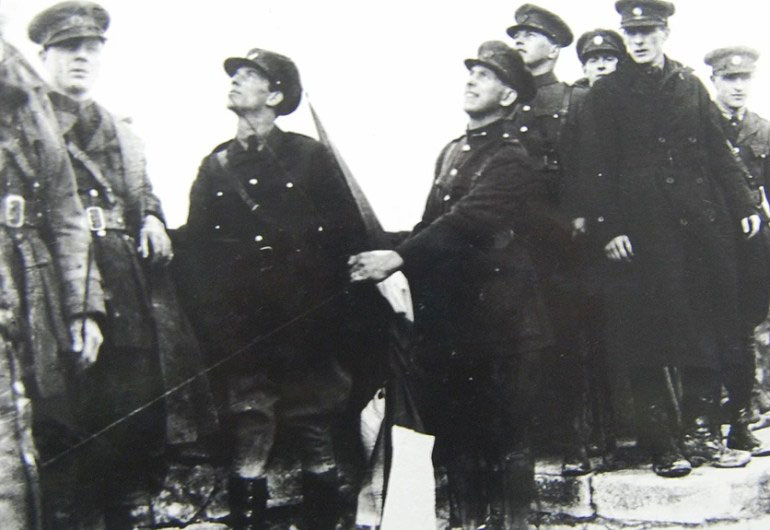A Flag Flies Once More

On the 28th February 1922, the Irish tricolor was raised above Athlone Castle, following an exodus of British troops earlier that day from Athlone Barracks. Change was afoot all over Ireland.
The Anglo Irish Treaty, signed on the 6th December 1921 and ratified by Dáil Éireann in January of 1922, paved the way for British Crown forces to leave most of Ireland. However, the Anglo Irish Treaty would cause deep divide amongst the people of Ireland, eventually leading to a very bitter, brutal and bloody civil War.
Under the terms of the Treaty, Ireland would be known as an Irish Free State, whereby members of its parliament would have to swear an oath of allegiance to the British Crown. This was not the intention of those who fought for their country during the Easter Rising of 1916. A fully independent Ireland was their dream and this was not realised when the Treaty was signed, debated upon and eventually ratified.
Ireland would remain a divided island, with the north of the country remaining part of the British Crown. In the months that followed, the true terms of the Treaty caused a catastrophic split in the Irish political arena. A civil war was to become the next inevitable step.
The Irish Civil War was a vicious and bloody time in Irish history, with brutal executions taking place on both sides of the split. But, whilst that civil war began in June of 1922, in the few months previous, the last bastions of British control were disappearing, slowly but surely. British troops were vacating and leaving their posts at barracks up and down the country.
Athlone Barracks was no different and that day came on the 28th February 1922. Major-General Sean MacEoin was in command to facilitate the handover of Athlone Barracks from British troops, many of whom had already departed in small detachments. Large companies of Irish troops, now the successors, were entering the town and the two armies met on the town bridge. It was a peaceful transition of power. MacEoin was in his element, delivering a speech to the people of Athlone who had been allowed access to the barracks square.
“Fellow soldiers and citizens of Athlone and the Midlands, this is a day for Athlone and a day for the Midlands. It is a day for Ireland, the first glorious day in over three hundred years”.
Invoking the memory of Sergeant Custume, a fallen hero of the Great Siege of Athlone of 1691, MacEoin continued;
“We see Sergeant Custume and the plain volunteer making their brave struggle on that old bridge. We see them tearing down plank after plank and firing shot after shot until the last plank went down the river forever. It is up to us now to maintain the high ideals of Custume and his men. As it has come to our hands once more, through no carelessness will it be lost. We have it and we will hold it”
Athlone Barracks had been known as Victoria Barracks under British control but was now to become known as Custume Barracks.
Following this rousing speech and the order for civilians to leave the barrack compound, MacEoin and his staff walked from their positions in the barrack square, up the rampart of the castle and proceeded to make their way to the battlements of the historic building.
The Irish tricolour was now to be raised above their position. A yacht mast had to be requisitioned because British troops had cut down the flagstaff that had flown the Union Jack. The raising of the Irish flag above the castle was the first time it had flown over the historic site in its long life. As the flag was raised, MacEoin’s men stood to attention, the officers saluted on the square below and a guard of honor fired three volleys. The Irish Tricolour was now flying proudly over Athlone.
*Photograph used with permission from The Aidan Heavey Public Library, Athlone.








